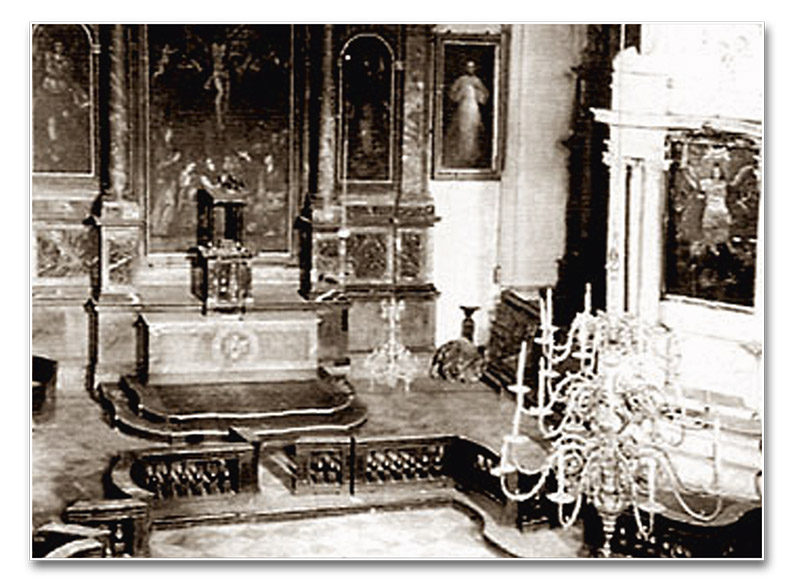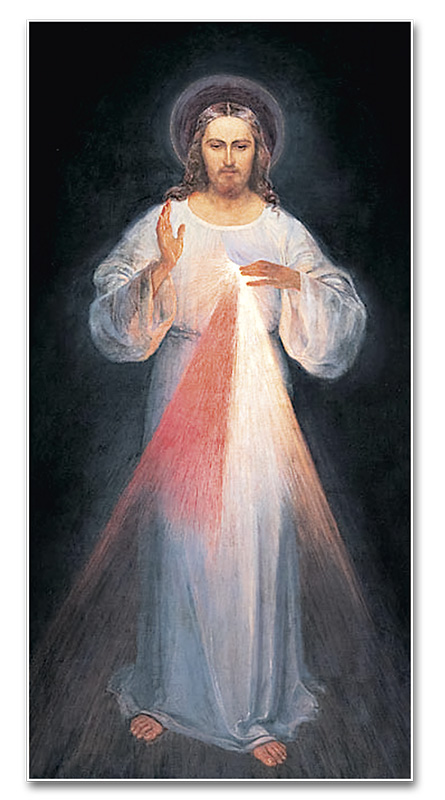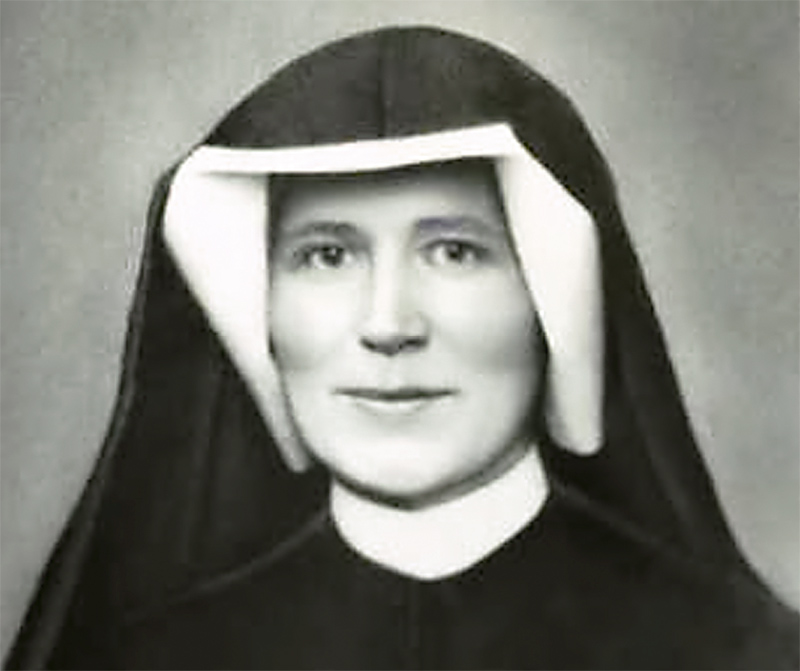Can this third millennium, immersed in pragmatism and practical atheism, come to understand an unlimited and disinterested love—a love that desires only the salvation of souls, and seeks only love in return?
The third millennium seems to have begun under the sign of uncertainty, insecurity, the threat of war and disillusionment. The technological advances of previous centuries brought conveniences and the ease of rapid communication, but failed to supply peace or an end to the sufferings of a humanity, which, like a ship lost at sea, seeks a guide to bring it safely to port.
From out of this affliction and uncertainty, a voice arose like a beacon: “Tell aching mankind to nestle close to My merciful Heart, and I will fill it with peace.1
This same voice continued: “The flames of mercy are burning Me. I desire to pour them out upon human souls. Oh, what pain they cause Me when they do not want to accept them!”
These are the words of Our Lord to Saint Maria Faustina Kowalska, a simple and modest soul called to be a herald of His Divine Mercy. Through her, Jesus revealed His boundless love for a humanity that seems to have forgotten Him.
She was born at the dawn of the twentieth century, became a religious in the Congregation of the Sisters of Our Lady of Mercy and lived in deep union with God. She fulfilled her daily duties in silence and suffering and practiced the heroic virtue that raised her to the honour of the altars. During her canonization ceremony, the Servant of God, John Paul II, affirmed that she was “a gift of God to our time.” 2

Called by God from childhood
Helena Kowalska was born on August 25, 1905, in the village of Glogowiec, Poland, into a poor farming family, the third of ten children. The home was imbued with the Catholic faith and from her earliest years, Helena desired to give herself entirely to God.
She writes that at the age of seven, she received the “definite call of God, the grace of a vocation to the religious life.” This call of grace accompanied her throughout her youth, even when she left home for a time to work as a maid to help support the family. At age 18, she earnestly appealed to her parents for permission to enter a convent, but they flatly refused, despite their daughter’s sincere entreaties.
Helena then sought to stifle the voice of her vocation that ceaselessly haunted her, by distracting herself with what she called the “vain things of life.” However, God had a great mission in store for her, and despite all obstacles, His will would triumph.
The decisive invitation
One day, Helena was with her sisters at a dance in the city of Lodz. She tried mixing with the other girls, but her soul felt sad and oppressed. Suddenly, in the middle of the dance, she saw Our Lord at her side, covered with wounds, and heard these words: “How long shall I put up with you and how long will you keep putting Me off?”
Deeply moved, she found a pretext to leave, and made her way to the nearby cathedral. She fell prostrate before the Blessed Sacrament, begging Our Lord to let her know what she should do next. She heard this reply: “Go at once to Warsaw; you will enter a convent there.”
With no other belongings than her one dress and the treasure of complete confidence and abandonment in the hands of Providence, Helena arose and set out for the capital.
The beginning of religious life
God tries those He loves. In Warsaw, she was refused entrance at several convents. Finally, on August 1, 1925, she knocked on the door of the Congregation of Our Lady of Mercy, dedicated to the rehabilitation of morally neglected girls. After a brief conversation, the Mother Superior told her to go to the Lord of the house and ask if He would accept her. With great joy, Helena went to the chapel and asked Jesus: “Lord of this house, do You accept me?” Immediately, she heard this voice: “I do accept; you are in My heart.” During her postulancy, Helena experienced profound doubts about her vocation, but bravely weathered these trials and, on April 30, 1926, received the novice’s habit and the name Sister Maria Faustina of the Blessed Sacrament.
The novitiate provided her with the opportunity of practicing her heart’s desire for perfection and union with God. Aware of her weakness and shortcomings, she cast herself into the arms of Our Lord, following the way of spiritual childhood of St. Thérèse of the Child Jesus.
Roses in place of potatoes
An incident during this time shows how deeply the young novice relied on God, even for apparent trifles. She was appointed by the superior to work in the kitchen, but found it difficult to manage the enormous pots and to drain the potatoes without spilling them. Disheartened by her ineptness, she tried to avoid this task, but this caused resentment among the other sisters.
The novice then asked Jesus for help. He responded with a clear interior voice telling her that from that day forward, she would find the strength to effortlessly fulfil this duty. On that same night, Sister Faustina drained the water off easily, and to her surprise, when she removed the lid, she found beautiful red roses instead of potatoes. She heard these words of Our Lord: “I change such hard work of yours into bouquets of most beautiful flowers and their perfume rise up to My throne.”
Afterwards, the saint had this to say: “Jesus, You have given me to know and understand in what a soul’s greatness consists; not in great deeds but in great love. Love has its worth, and it confers greatness on all our deeds. Although our actions are small and ordinary in themselves, because of love they become great and powerful before God.” This love of God was the meter by which she fulfilled her routine and extraordinary duties.
Mission as “apostle” of Divine Mercy
On May 1, 1933, Sister Faustina made her perpetual vows. Her mission as “apostle” of Divine Mercy had already been outlined through the ongoing revelations and messages from Jesus: “In the Old Covenant I sent prophets wielding thunderbolts to My people. Today, I am sending you with My mercy to the people of the whole world. I do not want to punish aching mankind, but I desire to heal it, pressing it to my Merciful Heart.”
The fervent sister gave herself wholeheartedly to this important mission, despite her misgivings about her abilities. “Secretary of My most profound mystery,” was the title given by Jesus to His “apostle” of Divine Mercy.
By the express will of the Divine Redeemer, she recorded the revelations she received: “Your task is to write down everything that I make known to you about My mercy, for the benefit of those who by reading these things will be comforted in their souls and will have the courage to approach Me.”
The pages of her Diary are filled with details of visions and intimate conversations with Our Lord and Our Lady, communications with angels, saints, and souls in purgatory, and even a description of a visit to hell and purgatory. Beautiful in its simplicity, yet of a surprisingly deep theology, the Diary is a treasury of teachings on Divine Mercy.
Making known the Saviour’s desires
Many of the revelations deal specifically with the Divine Mercy devotion, given by Jesus especially for these times: “Mankind will not have peace until it turns with trust to My mercy.”
Through these pages, Jesus reveals His ardent desire that souls humbly turn to Him and acknowledge their faults, allowing Him to pour forth His mercy, “so that every soul will praise My goodness. I desire trust from My creatures. Encourage souls to place great trust in My fathomless mercy. Let the weak, sinful soul have no fear to approach Me, for even if it had more sins than there are grains of sand in the world, all would be drowned in the unmeasurable depths of My mercy.”
Jesus Himself requested the spreading of this devotion so that the world might benefit from His boundless goodness: “I desire that priests proclaim this great mercy of Mine towards souls of sinners. Let the sinner not be afraid to approach Me. The flames of mercy are burning Me—clamouring to be spent; I want to pour them out upon these souls.”
This great mission brought suffering and misunderstanding upon the saint. Nonetheless, in 1933, Our Lord granted her help through a wise and prudent confessor, Fr. Michael Sopocko, who counselled and assisted her and guided her through her doubts and difficulties. Fr. Sopocko tirelessly spread devotion to the Divine Mercy until his death in 1975. Our Lord once said to Saint Faustina, “he is a priest after My own Heart.” He was beatified by Pope Benedict XVI on September 28, 2008.

Jesus orders a painting
On February 22 1931, St. Faustina received one of the most impressive revelations from the Lord Jesus. She saw Him clothed in a white garment, with one hand raised in a gesture of blessing. Two large rays streamed from His breast: one red, the other pale. She heard His divine voice, ordering her to have a picture painted according to the pattern she beheld, with the inscription: “Jesus, I trust in You.” Jesus added, “I promise that the soul that will venerate this image will not perish. I also promise victory over [its] enemies already here on earth, especially at the hour of death. I Myself will defend it as my own glory.”
In a later revelation, He explained the meaning of the two rays: “The pale ray stands for the Water which makes souls righteous. The red ray stands for the Blood which is the life of souls.”
After overcoming numerous obstacles, the picture was finally painted by Eugene Kazimirowski. The saint told the Lord that He was not nearly as beautiful as in the vision, but He consoled her by saying that the value of the image was not in the beauty of the colour nor the brush, but in His grace.
Our Lord asked her to have the picture solemnly blessed on the Sunday after Easter, which He instituted as the Feast of Mercy: “The first Sunday after Easter is to be the Feast of Mercy. On that day, priests are to tell everyone about my great and unfathomable mercy.”
Divine Mercy Devotions
In another vision, Our Lord revealed to her a prayer to placate the just wrath of God against the world, and He Himself taught her how to pray the “Divine Mercy Chaplet.”
“First of all, you will say one Our Father and Hail Mary and the I Believe in God. Then on the Our Father beads you will say the following words: ‘Eternal Father, I offer You the Body and Blood, Soul and Divinity of Your dearly beloved Son, Our Lord Jesus Christ in atonement for our sins and those of the whole world’. On the Hail Mary beads you will say the following words: ‘For the sake of His sorrowful Passion, have mercy on us and on the whole world.’ In conclusion, three times you will recite these words: ‘Holy God, Holy Mighty One, Holy Immortal Once, have mercy on us and on the whole world.’”
He also instituted the “Hour of Mercy,” at three o’clock in the afternoon, in which mankind should immerse itself in His mercy. This is the hour of “great mercy for the whole world,” in which “mercy triumphed over justice. He revealed that He refuses nothing to those who request something of Him at this hour, invoking the omnipotence of His Mercy, particularly for poor sinners.
“You are not living for yourself, but for souls”
Despite her extraordinary gifts, which included the hidden stigmata, prophecy, discernment of spirits and mystical betrothal, St. Faustina was deeply aware that holiness consists in fulfilling the will of God, even if this meant offering herself as a victim: “I know that the grain of wheat must be destroyed and ground between millstones in order to become food. In the same way, I must become destroyed in order to be useful to the Church and souls, even though externally no one will notice my sacrifice.”
Physical deterioration brought on by tuberculosis and the sufferings springing from the burden of her mission brought about her long desired oblation. At first, her community failed to realize the seriousness of her condition and some of the sisters accused her of laziness.
She was also the object of suspicion because of the extraordinary revelations and gifts she received, but she showed unfailing cheerfulness and goodness to all. Her kindness toward a sister who had particularly mistreated her was so heroic that one of the nuns exclaimed: “Sister Faustina must either be a fool or a saint, for truly an ordinary person would not tolerate having someone constantly do such things out of spite!” Her charity, patience and dedication also embraced the wards of the house. She embodied these words of Our Lord: “You are not living for yourself, but for souls.”
Graces that surpass our requests
After treatment in hospitals for her painful illness, Sister Faustina returned to the convent, where she surrendered her heroic soul to God, on October 5, 1938, at 33 years of age.
St. Faustina was canonized by the Servant of God John Paul II, on April 30, 2000—Divine Mercy Sunday. She illuminates our century with her mission and life. As a testimony to her extraordinary virtue, knowledge of and devotion to the Divine Mercy has spread worldwide, urging humanity to confidently surrender to the One who receives us with unfailing goodness. Our Lord himself told St. Faustina: “Souls that make an appeal to My mercy delight Me. To such souls I grant even more graces than they ask. I cannot punish even the greatest sinner if he makes an appeal to My compassion, but on the contrary, I justify him in My unfathomable and inscrutable mercy.” ◊
Notes







